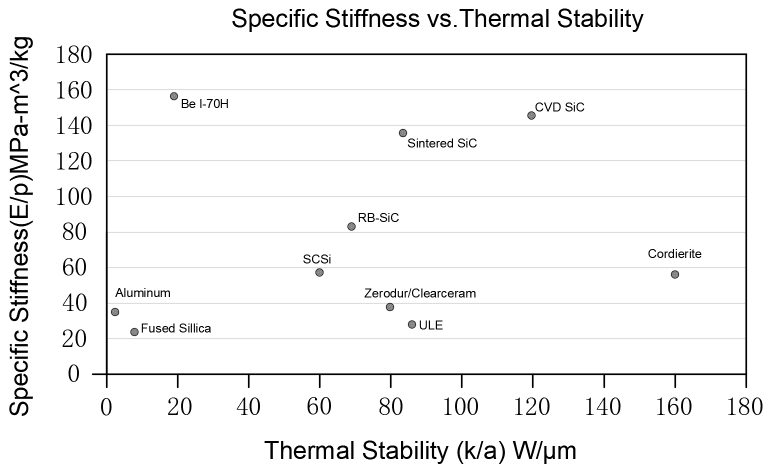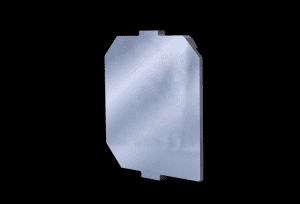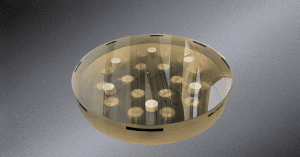Silicon Carbide Optics
There’s a reason that silicon carbide optics are becoming more and more prevalent in the semiconductor industry as well as in aerospace, astronomy, and high energy laser applications. If you work with high temperatures or in thermally variable environments, it’s a substrate you don’t want to miss.
SiC is a non-toxic material, and it can be formed into almost any shape desired. It has low density, a low coefficient of thermal expansion and excellent thermal stability, and it also has high specific stiffness and some important resonant frequency advantages. It can transmit heat a hundred times faster than glass, and exhibits more than four times the resistance to gravity deformation. What’s not to like about silicon carbide?

It turns out that though silicon carbon is ideal for many optical applications, it requires a knowledgeable user to make the most of it. There are many different types of silicon carbide, each with its own unique properties. In fact, silicon carbide exists in nearly 250 crystalline forms. Strength, stress, density, and other design parameters all depend on the manufacturing process, as do cost and production lead times. Understanding the nuances of silicon carbide optics and how they are manufactured is important to ensure top performance in your optical application, whether that’s in industry, research, or defense.
This article will introduce you to several different manufacturing processes used to produce this high-performance substrate. Silicon carbide SiC could well be the optimal choice for your application— when it’s done right. Done wrong, it could be little more than a liability.
Types of Silicon Carbide for Optical Use
Types of silicon carbide used in optical applications include:
- Reaction bonded SiC
- Sintered SiC
- 3D Printed SiC
- Hot press sintered SiC
- Reaction sintered SiC
- CVD SiC
- Converted SiC
The table below demonstrates how the properties of silicon carbide depend on manufacturing methods. A single parameter—- specific stiffness vs. thermal stability— is shown for several types of SiC and a number of other popular optical substrates.

Several types of silicon carbide may be used in one optic. Since chemical vapor deposition results in a type of SiC that can be polished to a much smoother finish than either sintered or reaction bonded SiC, it may be deposited as a cladding over sintered or reaction bonded SiC substrates.
Manufacturing Processes for Silicon Carbide Optics: A Closer Look
Reaction Bonded SiC
Reaction bonded SiC is one popular kind of silicon carbide. Graphite, a plasticizer, and silicon carbide powder are pressed in a preform, and the plasticizer is burned off. The porous structure that results is infiltrated with silicon, which reacts to the carbon (graphite) to form silicon carbide. The substrate that results from this manufacturing process includes residual silicon and carbon as well as silicon carbide. Since there are a number of variables in the process, the quality and mechanical properties of reaction bonded silicon carbide can vary depending on the manufacturer.
Sintered SiC
Sintered SiC is again manufactured from silicon carbide powder, but here heat and pressure is used to form a solid mass. The basic process involves mixing the powder with sintering aids such as carbon and boron, then pressing it into a mold. The powder is then sintered at high pressure and temperatures below the melting point of SiC.
There are a number of variations on the sintering process. Hot press sintered silicon carbide (HIP SiC) uses higher temperatures and pressures to produce a full density silicon carbide. Reaction sintered SiC involves the addition of silicon during the sintering phase, when the materials being processed are at about 1700K. The silicon reacts with 100% carbon used as a sintering aid, and the result is silicon carbide with extremely high flexural bending strength.

CVD SiC
Chemical vapor deposition is a more expensive technique than either reaction bonding or sintering, but it results in an extremely pure silicon carbide with very good thermal conductivity. The SiC produced by chemical vapor deposition is high density, with a cubic structure, and can be polished very smooth.
To produce CVD SiC, a wafer is heated to a high temperature and exposed to precursors that contain silicon and carbon. These precursors are reduced to form silicon carbide, and by-products are eliminated with the gases.
SiC Optics at Avantier
At Avantier, we design and produce custom high performance SiC optics for clients in many fields. Visit our product page for more info, or contact us to set up an initial consult.
GREAT ARTICLE!
Share this article to gain insights from your connections!





